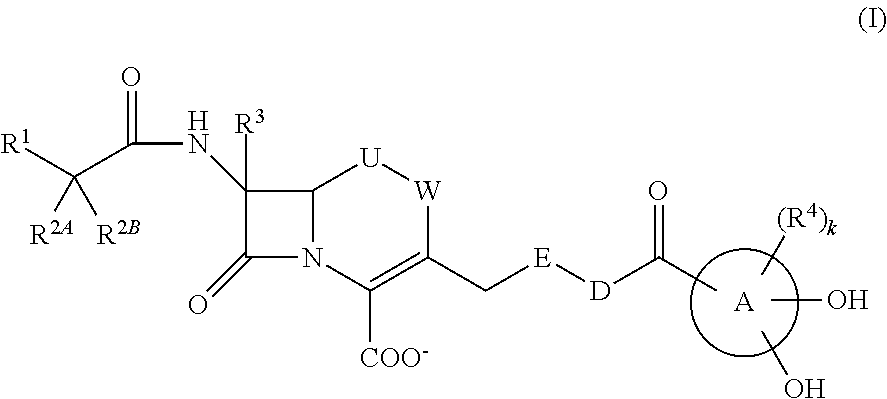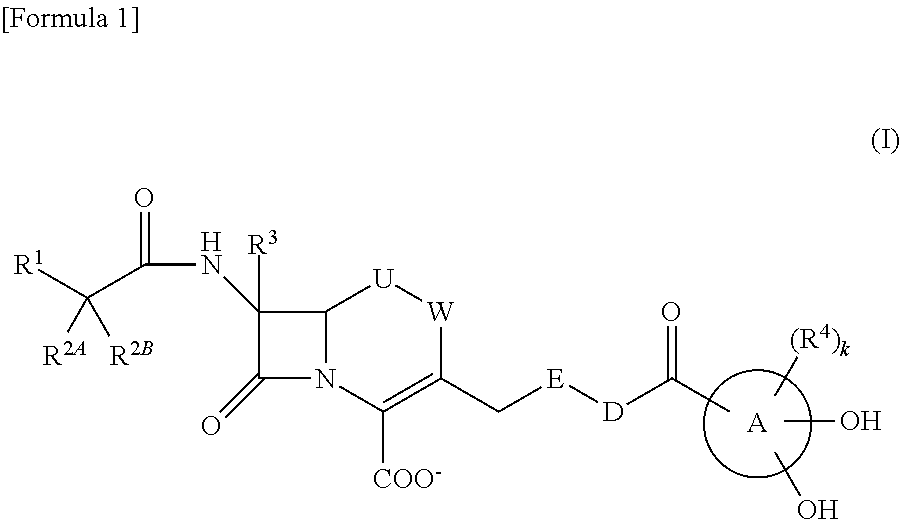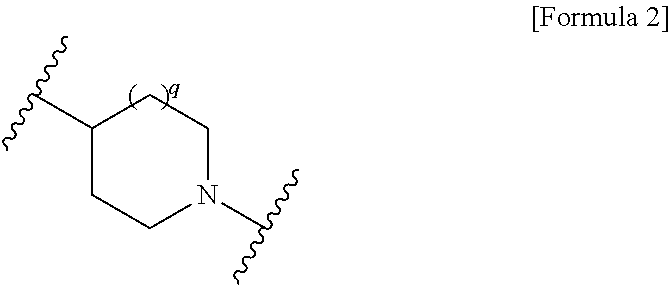Cephem derivative
a technology of cephem and derivatives, applied in the field of cephem compounds, can solve problems such as clinical problems
- Summary
- Abstract
- Description
- Claims
- Application Information
AI Technical Summary
Benefits of technology
Problems solved by technology
Method used
Image
Examples
example 1
Synthesis of Compound (I-1)
[0230]
Step: Production of Compound (I-1) from Compound 2+Compound 3 via Compound 4
[0231]A solution of Compound 2 (1.07 g, 1.0 mmol) in methylene chloride (10 ml) was cooled to 0° C. Compound 3 (303 mg, 0.95 mmol), pyridine (105 μl, 1.3 mmol), and hydrochloric acid salt of 1-ethyl-3-(3-dimethylaminopropyl)carbodiimide (230 mg, 1.2 mmol) were added successively thereto, and then stirred at 0° C. for 3.5 hours. To the reaction mixture, 0.1 mol / L hydrochloric acid, ethyl acetate, and tetrahydrofuran were added, and then methylene chloride was evaporated under reduced pressure, followed by extraction with mixed solvent of ethyl acetate / tetrahydrofuran. The organic layer was washed with 0.1 mol / L hydrochloric acid, aqueous sodium hydrogen sulfite solution, then saturated brine, and then the solvent was evaporated under reduced pressure. The resulting concentrated residue was dissolved in methylene chloride, and then dried with anhydrous magnesium sulfate. After ...
example 2
Synthesis of Compound (I-2)
[0239]
Step: Production of Compound (I-2) from Compound 2+Compound 6 via Compound 7
[0240]A solution of Compound 6 (238 mg, 1.1 mmol) in methylene chloride (10 ml) was cooled to 0° C. Diisopropylethylamine (480 μl, 2.75 mmol) followed by trimethylchlorosilane (422 μl, 3.3 mmol) were added, and then stirred at room temperature for 2 hours. After the reaction mixture was cooled to −30° C., thionyl chloride (96 μl, 1.32 mmol) was added thereto, and then stirred at 0° C. for 1 hour to form a solution of the acid chloride. Meanwhile, Compound 2 (1.07 g, 1.0 mmol) was dissolved in methylene chloride (10 ml), and then cooled to −60° C. Subsequently, tributylamine (951 μl, 4.0 mmol) was added thereto. To the resulting mixed solution, the above-described solution of the acid chloride was added dropwise over 30 minutes. After stirring at 0° C. for 1 hour, 0.5 mol / L hydrochloric acid was added to the reaction mixture, followed by extraction with methylene chloride. The...
example 3
Synthesis of Compound (I-3)
[0248]
Step: Production of Compound (I-3) from Compound 2+Compound 9 via Compound 10
[0249]The synthesis was carried out as described in Example 1 using Compound 2 (1.07 g, 1.0 mmol) and Compound 9 (415 mg, 0.95 mmol). After purification by ODS column chromatography, to the fractions containing the desired compound, aqueous 0.2 mol / L sodium hydroxide solution was added to adjust pH=6.0, and then a piece of dry ice was added. The resulting solution was concentrated in vacuo, and then lyophilized to yield Compound (I-3) as a white powder.
[0250]Yield: 160 mg (23%)
[0251]1H-NMR (D2O) δ: 2.14 (4H, br), 3.31-4.06 (12H, m), 4.42 (1H, d, J=5.7 Hz), 5.15 (1H, dd, J=5.1, 14.7 Hz), 5.63 (1H, dd, J=4.8, 8.1 Hz), 6.81 (1H, d, J=8.4 Hz), 6.87 (2H, br), 7.17 (1H, d, J=7.2 Hz)
[0252]MS (m+1)=675.27
[0253]Elemental analysis for: C30H30ClN4O10SNa.4.0H2O
[0254]Calcd.: C, 46.85; H, 4.98; Cl, 4.61; N, 7.28; S, 4.17; Na, 2.99(%).
[0255]Found. C, 46.83; H, 4.88; Cl, 4.88; N, 7.20; S, 3...
PUM
| Property | Measurement | Unit |
|---|---|---|
| temperature | aaaaa | aaaaa |
| temperature | aaaaa | aaaaa |
| temperature | aaaaa | aaaaa |
Abstract
Description
Claims
Application Information
 Login to View More
Login to View More - R&D
- Intellectual Property
- Life Sciences
- Materials
- Tech Scout
- Unparalleled Data Quality
- Higher Quality Content
- 60% Fewer Hallucinations
Browse by: Latest US Patents, China's latest patents, Technical Efficacy Thesaurus, Application Domain, Technology Topic, Popular Technical Reports.
© 2025 PatSnap. All rights reserved.Legal|Privacy policy|Modern Slavery Act Transparency Statement|Sitemap|About US| Contact US: help@patsnap.com



